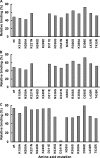Molecular basis for broad neuraminidase immunity: conserved epitopes in seasonal and pandemic H1N1 as well as H5N1 influenza viruses
- PMID: 23785204
- PMCID: PMC3754050
- DOI: 10.1128/JVI.01203-13
Molecular basis for broad neuraminidase immunity: conserved epitopes in seasonal and pandemic H1N1 as well as H5N1 influenza viruses
Abstract
Influenza A viruses, including H1N1 and H5N1 subtypes, pose a serious threat to public health. Neuraminidase (NA)-related immunity contributes to protection against influenza virus infection. Antibodies to the N1 subtype provide protection against homologous and heterologous H1N1 as well as H5N1 virus challenge. Since neither the strain-specific nor conserved epitopes of N1 have been identified, we generated a panel of mouse monoclonal antibodies (MAbs) that exhibit different reactivity spectra with H1N1 and H5N1 viruses and used these MAbs to map N1 antigenic domains. We identified 12 amino acids essential for MAb binding to the NA of a recent seasonal H1N1 virus, A/Brisbane/59/2007. Of these, residues 248, 249, 250, 341, and 343 are recognized by strain-specific group A MAbs, while residues 273, 338, and 339 are within conserved epitope(s), which allows cross-reactive group B MAbs to bind the NAs of seasonal H1N1 and the 1918 and 2009 pandemic (09pdm) H1N1 as well as H5N1 viruses. A single dose of group B MAbs administered prophylactically fully protected mice against lethal challenge with seasonal and 09pdm H1N1 viruses and resulted in significant protection against the highly pathogenic wild-type H5N1 virus. Another three N1 residues (at positions 396, 397, and 456) are essential for binding of cross-reactive group E MAbs, which differ from group B MAbs in that they do not bind 09pdm H1N1 viruses. The identification of conserved N1 epitopes reveals the molecular basis for NA-mediated immunity between H1N1 and H5N1 viruses and demonstrates the potential for developing broadly protective NA-specific antibody treatments for influenza.
Figures







References
-
- Palese P, Tobita K, Ueda M, Compans RW. 1974. Characterization of temperature sensitive influenza virus mutants defective in neuraminidase. Virology 61:397–410 - PubMed
-
- Lakdawala SS, Lamirande EW, Suguitan AL, Jr, Wang W, Santos CP, Vogel L, Matsuoka Y, Lindsley WG, Jin H, Subbarao K. 2011. Eurasian-origin gene segments contribute to the transmissibility, aerosol release, and morphology of the 2009 pandemic H1N1 influenza virus. PLoS Pathog. 7:e1002443.10.1371/journal.ppat.1002443 - DOI - PMC - PubMed
-
- Tong S, Li Y, Rivailler P, Conrardy C, Castillo DA, Chen LM, Recuenco S, Ellison JA, Davis CT, York IA, Turmelle AS, Moran D, Rogers S, Shi M, Tao Y, Weil MR, Tang K, Rowe LA, Sammons S, Xu X, Frace M, Lindblade KA, Cox NJ, Anderson LJ, Rupprecht CE, Donis RO. 2012. A distinct lineage of influenza A virus from bats. Proc. Natl. Acad. Sci. U. S. A. 109:4269–4274 - PMC - PubMed
-
- Pappas C, Aguilar PV, Basler CF, Solorzano A, Zeng H, Perrone LA, Palese P, Garcia-Sastre A, Katz JM, Tumpey TM. 2008. Single gene reassortants identify a critical role for PB1, HA, and NA in the high virulence of the 1918 pandemic influenza virus. Proc. Natl. Acad. Sci. U. S. A. 105:3064–3069 - PMC - PubMed
Publication types
MeSH terms
Substances
Grants and funding
LinkOut - more resources
Full Text Sources
Other Literature Sources
Medical

